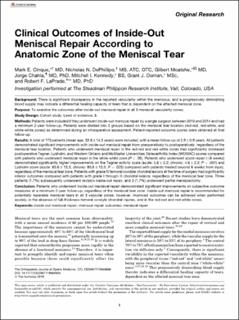| dc.contributor.author | Cinque, Mark E. | |
| dc.contributor.author | DePhillipo, Nicholas | |
| dc.contributor.author | Moatshe, Gilbert | |
| dc.contributor.author | Chahla, Jorge | |
| dc.contributor.author | Kennedy, Mitchell I. | |
| dc.contributor.author | Dornan, Grant J. | |
| dc.contributor.author | LaPrade, Robert F. | |
| dc.date.accessioned | 2020-05-11T09:54:18Z | |
| dc.date.available | 2020-05-11T09:54:18Z | |
| dc.date.created | 2019-09-10T13:13:47Z | |
| dc.date.issued | 2019 | |
| dc.identifier.citation | The Orthopaedic Journal of Sports Medicine. 2019, 7(7), 2325967119860806. | en_US |
| dc.identifier.issn | 2325-9671 | |
| dc.identifier.uri | https://hdl.handle.net/11250/2653839 | |
| dc.description | This article is distributed under the terms of the Creative Commons Attribution-NonCommercial-NoDerivs 4.0 License (http://www.creativecommons.org/licenses/by-nc-nd/4.0/) which permits non-commercial use, reproduction and distribution of the work as published without adaptation or alteration, without further permission provided the original work is attributed as specified on the SAGE and Open Access pages (https://us.sagepub.com/en-us/nam/open-access-at-sage). | en_US |
| dc.description.abstract | Background: There is significant discrepancy in the reported vascularity within the meniscus, and a progressively diminishing blood supply may indicate a differential healing capacity of tears that is dependent on the affected meniscal zone. Purpose: To examine the outcomes after inside-out meniscal repair in all 3 meniscal vascularity zones. Study Design: Cohort study; Level of evidence, 3. Methods: Patients were included if they underwent inside-out meniscal repair by a single surgeon between 2010 and 2014 and had a minimum 2-year follow-up. Patients were divided into 3 groups based on the meniscal tear location (red-red, red-white, and white-white zones) as determined during an intraoperative assessment. Patient-reported outcome scores were obtained at final follow-up. Results: A total of 173 patients (mean age, 33.6 ± 14.3 years) were included, with a mean follow-up of 2.9 ± 0.9 years. All patients demonstrated significant improvements with inside-out meniscal repair from preoperatively to postoperatively, regardless of the meniscal tear location. Patients who underwent meniscal repair in the red-red and red-white zones had significantly increased postoperative Tegner, Lysholm, and Western Ontario and McMaster Universities Osteoarthritis Index (WOMAC) scores compared with patients who underwent meniscal repair in the white-white zone (P < .05). Patients who underwent acute repair (≤6 weeks) demonstrated significantly higher improvements on the Tegner activity scale (acute: 5.8 ± 2.2; chronic: 4.6 ± 2.2; P = .001) and Lysholm score (acute: 85.6 ± 13.3; chronic: 80.8 ± 13.5; P = .025) compared with patients treated beyond 6 weeks from injury, regardless of the meniscal tear zone. Patients with grade IV femoral condyle chondral lesions at the time of surgery had significantly inferior outcomes compared with patients with grade I through III chondral lesions, regardless of the meniscal tear zone. Three patients (1.7%) subsequently underwent revision inside-out repair, and 3 (1.7%) underwent partial meniscectomy. Conclusion: Patients who underwent inside-out meniscal repair demonstrated significant improvements on subjective outcome measures at a minimum 2-year follow-up, regardless of the meniscal tear zone. Inside-out meniscal repair is recommended for potentially reparable meniscal tears in all 3 vascular zones; however, improved outcomes can be achieved when performed acutely, in the absence of full-thickness femoral condyle chondral injuries, and in the red-red and red-white zones. | en_US |
| dc.language.iso | eng | en_US |
| dc.subject | inside-out meniscal repair | en_US |
| dc.subject | meniscal repair outcomes | en_US |
| dc.subject | meniscal repair | en_US |
| dc.title | Clinical Outcomes of Inside-Out Meniscal Repair According to Anatomic Zone of the Meniscal Tear | en_US |
| dc.type | Peer reviewed | en_US |
| dc.type | Journal article | en_US |
| dc.description.version | publishedVersion | en_US |
| dc.rights.holder | (c) The Author(s) 2019. | en_US |
| dc.source.pagenumber | 1-8 | en_US |
| dc.source.volume | 7 | en_US |
| dc.source.journal | The Orthopaedic Journal of Sports Medicine | en_US |
| dc.source.issue | 7 | en_US |
| dc.identifier.doi | 10.1177/2325967119860806 | |
| dc.identifier.cristin | 1723282 | |
| dc.description.localcode | Seksjon for idrettsmedisinske fag / Department of Sports Medicine | en_US |
| cristin.ispublished | true | |
| cristin.fulltext | original | |
| cristin.qualitycode | 1 | |
